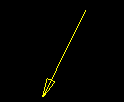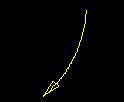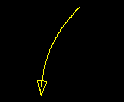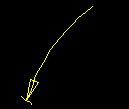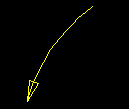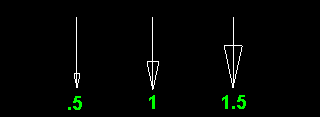The Pointer Edit window ( Drawing Editor )
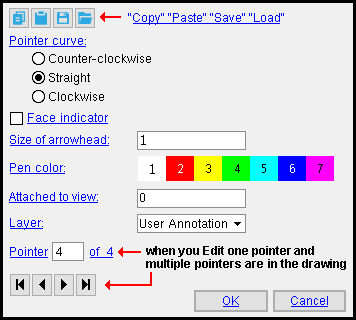
Settings on this window are read-only if you are editing a pointer that is not on a comment layer and your current drawing is not a crane placement drawing . If your current drawing is a crane placement drawing, you can add or edit objects on non-comment layers as well as on comment layers. Instructions on this page assume you are NOT in a crane placement drawing.
- This window does not appear during Pointer Add . Nevertheless, it sets the defaults for Pointer Add -- see " OK ."
contents | objects > pointers > | objects -- pointers | top
![]() " Copy " " Paste " " Save " " Open " buttons
" Copy " " Paste " " Save " " Open " buttons
These buttons appear on this window only if the pointer (or pointers) you are editing are on a comment layer .
You'll find buttons like these at the top of this window. They apply to all user-editable settings that are on this window. Click here for more information.
You can " Copy " (
) the settings on this window, then change the " Pointer__of " number you are editing using the VCR buttons, then " Paste " (
) those settings to the newly selected pointer.
" Save " (
) saves a file to the
form/pointer folder that is used by your current version of this program. Give the file a name that will help users in other Jobs on your network identify its purpose. " Open " (
) changes all settings on this window to those settings that are stored in the file that you select.
" Paste " and " Open " replace mixed entries to a single field with a single entry. " Copy " and " Save " ignore fields with mixed entries, treating them as if they have no entry or do not exist.
Pointer curve: Straight or Clockwise or Counter-clockwise . This sets direction of the curvature of the pointer.
|
|||||
| Tip: Hold down the Shift key and drag the middle of the pointer in Select Items mode to straighten the pointer or change its curvature . |
Face indicator: ![]() or
or ![]() . The face indicator is a wavy line drawn under the tip of a pointer to indicate that the pointer is over the face of a material.
. The face indicator is a wavy line drawn under the tip of a pointer to indicate that the pointer is over the face of a material.
|
Size of arrowhead: a number less than 1 or 1 or a number greater than 1 .
|
' A number less than 1 ' reduces the size of an arrowhead relative to an arrowhead size of 1. For example, a size .5 arrowhead is 1/2 the size of a size 1 arrowhead. A size .75 arrowhead is 3/4 the size of a size 1 arrowhead.
' 1 ' is the standard size of an arrowhead. In pre-2018 versions of SDS2 software, all arrowheads were this size.
' A number greater than 1 ' increases the size of an arrowhead relative to what its size 1 size would be. For example, a size 1.5 arrowhead is 1 1/2 times the size of a size 1 arrowhead. A size 2 arrowhead is 2 times the size of a size 1 arrowhead.
Default: The " Size of pointer arrowheads " in Drawing Presentation ( Fabricator Setup ) sets the size of arrowheads for all auto detailed pointers and for the first pointer that is added during a Drawing Editior session.
Pen color: 1 or 2 or 3 or 4 or 5 or 6 or 7 .

The selected button sets the printing pen number (and on-screen display color) of the dimension lines. Line Weights assigns a particular thickness to each " Pen color ."
Attached to view: A number designating the view that this pointer is attached to. This applies mainly to member details , since member details are likely to show more views than submaterial details , the only other type of drawing on which you might find multiple views. For instance, a column detail may have a view of face A, face B and face C. It may also have various section views (Section A-A, Section B-B, Section C-C). All graphical objects that are in a particular view are assigned the same number.
Assigning the correct number to an object (line, weld symbol, label, etc.) provides maximum compatibility when the comment layer you add that object to is viewed or printed in a full-featured SDS2 program .
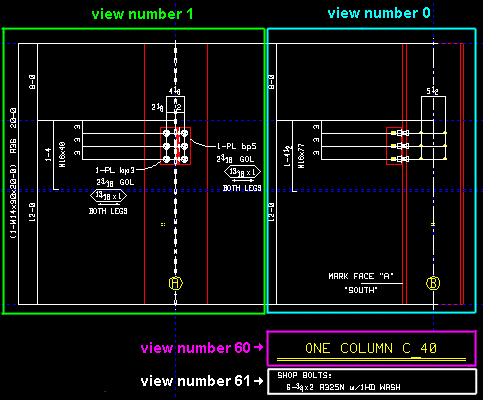
To show a view's number, you can add the X-Y-Z Display to your toolbar.

In the Drawing Editor , the X-Y-Z Display shows the view number that the point location target (
) is over.
Layer: the drawing layer (any layer given a " Name ") that the pointer you are editing will be drawn on after you press " OK " to close this window. If that layer happens to be hidden (not marked " Show "), the pointer disappears after the first Redraw .
![]()
If the layer listed here is a non-comment layer, options on this window are read-only.
If this window is editable, you can only select a comment layer from the list box's selection menu (
).
Pointer _ of __: The number of the pointer you are editing and the total number of pointers in your current drawing. You can use the VCR buttons to select a different pointer that is on a comment layer and edit that pointer's settings using this window. When a pointer on a shown layer is selected, it is displayed in green (cyan if its actual color is green). The selected pointer must be on a shown layer for it to be shown.
|
|
| VCR buttons (first-previous-next-last) for selecting a pointer to edit. |
Note: If you change one pointer, then select a different pointer number, the first pointer remains changed even if you press " Cancel " on this window.
contents | objects > pointers > | objects -- pointers | top
Possibility #1 :
Press the " OK " button if this window is for review only
(if you are editing a pointer that is not on a comment layer ).
Possibility #2 :
If you are editing a pointer on a comment layer,
the bottom of this window will show the following buttons:
![]()
![]()
"OK" (or the Enter key) closes this window and completes the Pointer Edit or Pointer Edit All operation.
Defaults: When you press " OK ," the settings on this window -- except mixed entries -- become the default settings for the next pointer you Add during this session of the Drawing Editor . Even if all you do is double-click a pointer that is on a comment layer and press " OK " without making any changes on this window, this window's settings become the defaults for the next-added pointer. The settings on this window do not become the defaults for new pointers if you press " Cancel " to close this window (unless you used the " Pointer _ of __ " widget).
"Cancel" (or the Esc key or the ![]() button) closes this window without saving any of the changes you have made. In the case of an Edit Pointer operation where you have changed more than one pointer, " Cancel " only cancels the changes made to the pointer whose number is currently selected in the " Pointer _ of __ " widget.
button) closes this window without saving any of the changes you have made. In the case of an Edit Pointer operation where you have changed more than one pointer, " Cancel " only cancels the changes made to the pointer whose number is currently selected in the " Pointer _ of __ " widget.
Tip 1: Although " Cancel " does not cancel all changes you have made on this window if you used " Pointer _ of __ " to edit more than one pointer, Undo does undo all those changes.
Tip 2: If you double-click a pointer that is on a comment layer just to review it and don't want to set the defaults for to-be-added pointers, the best way to close this window is to press " Cancel. "
